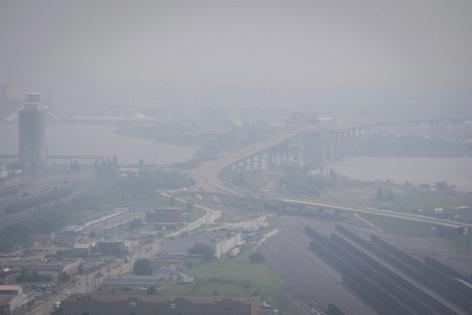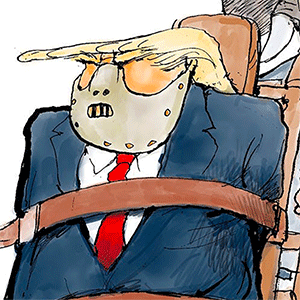Wildfire smoke ignites more cross-border tensions between Minnesota and Canada
Published in Science & Technology News
MINNEAPOLIS — Minnesota and Canada share so much: frigid winters, a love for hockey — and more recently, massive plumes of toxic wildfire smoke sending people indoors in the peak of summer.
It’s that latter experience that’s driving the two neighbors apart and adding to U.S.-Canadian tensions, as Minnesota endures one of its smokiest summers on record from fires burning north of the border.
A group of Republican lawmakers from Minnesota is publicly berating the Canadian government, criticizing its handling of hundreds of fires that have polluted their districts, sullying summer tourism and, at times, giving Minnesota some of the worst air in the world.
This week, state Rep. Elliott Engen of Lino Lakes, a Republican, filed a complaint asking the U.S. Environmental Protection Agency and the International Joint Commission, a body created to help resolve cross-border disputes, to investigate Canada’s handling of the fires.
“Over 20 million residents in the Midwest have faced restrictions on outdoor activities due to dangerous air quality, with communities reporting burning throats, respiratory issues, and reduced visibility,” said the complaint, which was also signed by Republican lawmakers from Iowa, Wisconsin and North Dakota.
That follows a July letter from six GOP members of Congress, including four from Minnesota, blaming Canada for the fires and calling for a change in forest management practices.
It’s the latest political spat to emerge between the United States and Canada this year, which has been marked by ongoing tariff disputes and the U.S. president suggesting that the Great White North should really be the 51st state.
“Our summers are short enough, we want to get out and enjoy it,” U.S. Rep. Pete Stauber, R.-Minn., told the Minnesota Star Tribune this week. Stauber was among the Congress members who signed last month’s critical letter to Canada.
“My constituents are being devastated because of the unhealthy air that we’re breathing, and I hear it every day,” he said.
Stauber said Canada could better address wildfires by harvesting mature trees, which he says will prevent them from rotting and becoming fuel for the fires.
Canadians have pushed back against the criticisms. This week, Manitoba Premier Wab Kinew accused the Midwest lawmakers of throwing a “timber tantrum” and playing “political games” with one of Canada’s worst wildfire seasons on record.
“These are attention-seekers who can’t come up with a good idea on health care or on making life more affordable,” Kinew told the Canadian Press. “So they’re playing games with something that’s very serious.”
Some also noted that the U.S. lawmakers, all of whom have been Republican, aren’t acknowledging their own nation’s role in exacerbating those fires through carbon pollution that’s warming the climate.
In a statement to the Star Tribune, Engen said Canada has an obligation under international agreements to address cross-border pollution.
“While there might not be an immediate solution, there are resources that should be utilized and reviews that can be conducted to better prepare for future wildfire risks,” he wrote.
Beyond the political back-and-forth, state firefighters have been doing what they can to help. Since early June, Minnesota has sent 71 firefighters into Manitoba to dig fire lines and offer other assistance as the Canadian province battles its worst fire season in 30 years, said a spokesperson for the Minnesota Interagency Fire Center.
This year alone, Canada has seen more than 4,000 fires break out, the country’s data shows, scorching more than 17 million acres of forest. Experts say it’s likely 2025 will be the country’s second worst year for wildfires, behind 2023.
Canadian fire officials and forestry experts told the Star Tribune that there are steps both Canada and the U.S. could take to better address the wildfire problem, but they fear the political rancor is getting in the way of that conversation.
In April, the Canadian Association of Fire Chiefs (CAFC) called on their government to establish a national fire agency, which they said is necessary to better coordinate firefighting efforts across the country.
Currently, both the Canada and the U.S. coordinate wildland firefighting efforts through ad hoc coalitions of various local, state and federal emergency management agencies and fire departments, which can fracture resources and slow response times.
“The Canadian fire chiefs have been calling for a National Fire Administration for about 10 years now,” said CACF President Ken McMullen, noting that firefighting is the only emergency response department that doesn’t have an official home in the Canadian federal governments.
The association also called for more funding to replace outdated and broken firefighting equipment. A 2024 survey of Canadian fire departments found that more than half of them are in need of new gear but unable to attain it due to costs or other obstacles.
Lori Daniels, a forest ecologist at the University of British Columbia, agreed that there are things both Canada and the U.S. could be doing better to handle their wildfires. But Daniels, whose studies include forestry management, said it’s unrealistic to think that simply harvesting more timber will resolve Canada’s fire problem, noting that they’re dealing with hundreds of wildfires spread across a vast area, much of which is only accessible by aircraft.
Canada’s forests span more than 1.4 million square miles, accounting for nearly 9% of forests worldwide, according to Natural Resources Canada. That’s enough area to fit the entire country of India or about half of the contiguous United States.
“We’ve tried for many years on both sides of the border just to cut down the mature trees, maximize our profit, and think that we were going to benefit from that,” Daniels said. “So frankly, it hasn’t worked. You’re getting fires all over the United States. We have fires all over Canada.”
Instead, she said, the U.S. and Canada should focus on long-term solutions to wildfires, such as restoring wetlands to act as natural fire barriers and implementing more prescribed burns where it’s appropriate to clear underbrush and other fuels on the forest grounds. Daniels said 70 years of fire suppression is what allowed so much fuel to stockpile on the forest ground.
On Thursday, President Donald Trump’s latest round of tariffs took effect, including a new 35% tariff on Canada. The president cited frustrations with fentanyl crossing over the border as the reason for the new import tax.
McMullen said the tariffs are just one more factor that is making it more difficult for Canada to snuff out its fires. Fire equipment costs have risen 30% since last year, in part due to escalating tariffs and inflation, he said, so any tariff exemptions for emergency response equipment would likely help.
Just three years ago, a fire truck cost $850,000, McMullen said. “Today, that truck is $1.4 [million] or $1.5 million.”
©2025 The Minnesota Star Tribune. Visit startribune.com. Distributed by Tribune Content Agency, LLC







Comments